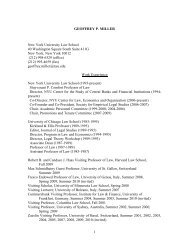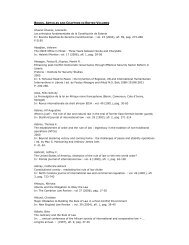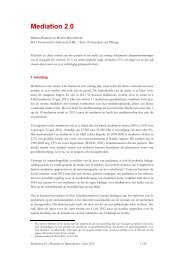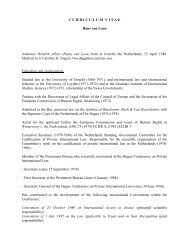Trend Report | Part 1 - HiiL
Trend Report | Part 1 - HiiL
Trend Report | Part 1 - HiiL
You also want an ePaper? Increase the reach of your titles
YUMPU automatically turns print PDFs into web optimized ePapers that Google loves.
This report assessed what is needed to ensure basic justice care for everyone and which approaches are<br />
promising to achieve that goal. The analysis suggests the following conclusions:<br />
Most justice problems are human problems: similar across the globe<br />
The commonalities in the most frequent legal needs around the world, such as good solutions for divorce,<br />
inheritance and land disputes, are larger than the differences. This is both true for the typology of the<br />
problem and for the solutions that work. The best way forward is through a path of collaborative learning<br />
and sharing experiences. We have relied on normative approaches in the study of law and legal conflicts<br />
for a long time. Now the biggest steps forward can be made by sharing sound, evidence-based methods<br />
to solve the problems that every person on earth is most likely to encounter in the relationships that<br />
matter most.<br />
Problems are mostly local and relational<br />
The problems with the highest impact tend to come up in key relationships between people living or<br />
working together for a long time and investing much in these relationships. In a group of a 1000 adult<br />
people, 300 problems per year may be expected. There could be between 10 and 30 family issues<br />
(divorce, inheritance) coming up each year and around 20 neighbour problems. In developed economies,<br />
30 to 60 such problems related to employment (termination) can be expected to show up. In poorer<br />
countries less people report such conflicts, but land and housing issues (property rights, tenure, eviction)<br />
are more prominent. The more vulnerable the people are, the greater their reliance on these close<br />
relationships, and the greater the impact of such conflicts on their lives. Even violence often occurs in<br />
these key relationships: domestic or between neighbours.<br />
Access to documents proving identity, and access to government services, are also frequent and rather<br />
urgent problems, as are theft and debt problems. In groups and countries with higher incomes,<br />
consumer issues about goods and services purchased are the most frequent problems (50-100 of the<br />
300 problems each year), but they do not disrupt lives as much, and resolution is slightly less urgent.<br />
Access to health care issues, accidents and victimization by major crimes are less frequent (around 10<br />
of the 300), but have a high impact everywhere.<br />
Relying on existing capabilities: when people ask for justice and when they try to deliver it.<br />
The most urgent justiciable problems are thus connected to life events. They are often local and related<br />
to unexpected change, long existing patterns of interaction and escalation. Solving them requires more<br />
than applying existing norms to facts that have happened in the past. The solution has to be accepted<br />
and integrated into the mostly local relationships.<br />
So it is not surprising that people take local action on these problems. Most problems are solved through<br />
communication and negotiation. With help available in their vicinity, people settle. If they do not succeed<br />
in this, or if they fear the confrontation, they ask third parties to intervene. Addressing a formal court of<br />
law is only one of the options, but the availability of third parties who can induce the other party to<br />
cooperate to a fair outcome is crucial.<br />
The rule of law and access to justice are better served by improving concrete practices than by taking on<br />
the legal system as a whole. People are already working on improvements, very hard, and in many ways.<br />
Lawyers and many others contribute. They do this because there is an enormous demand for access to<br />
justice. Where there is demand, mechanisms to supply will be developed. These processes should be<br />
nurtured, helping to overcome the many challenges. Justice partly consists of public goods, yet private<br />
actors are often in a position that they can act more quickly and learn faster. These private processes<br />
can generally be trusted, although both private processes and those supported by public money should<br />
be monitored independently.<br />
<strong>HiiL</strong> <strong>Trend</strong> <strong>Report</strong> – <strong>Part</strong> 1: Challenges and Promising Approaches 136













